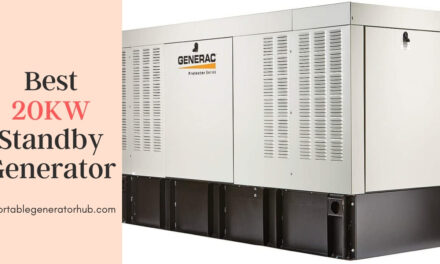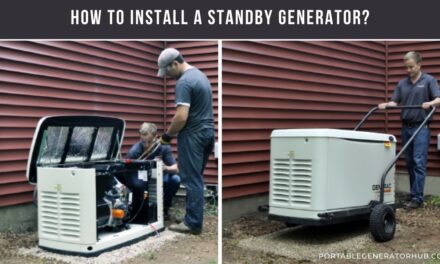
According to a reliable source, every home in the United States of America encounters a power outage twice a year. And the power outage lasts for an average of 3 hours. It may get worse when a natural disaster occurs.
The outage could go on for several days and this leads to a litany of woes for the victims. Spoilt food, frozen pipes, moldy walls, and even a flooded basement are some of the challenges brought by power outages.
The only way to prevent this is to install a standby generator that will kick in when the power goes out. In the process of searching for the appropriate generator for their homes, prospective buyers ask this question – What size of a generator can power my home?
Correcting The Wrong Impression
First of all, we need to correct a wrong impression. People assume that bigger generators always generate more power than smaller ones. That’s why they are concerned with the size of their generators.
Here is the truth. Yes, sometimes, bigger generators give more power output than smaller ones, but it is not in all cases.
Sometimes lighter or slightly smaller generators may offer a higher power output than bigger and heavier ones. So, don’t be deceived with size.
What you should focus on is the power output. A 20KW generator will generate 20KW or 20,000 watts. Hence, the ideal question should be, what generator capacity do I need?
How to Determine The Appropriate Standby Generator Capacity For Your Home?
We can’t answer this question because the answer differs for different homes. The right generator for you depends on your total power consumption. So, here the steps to take.
Step 1 – List out all the electrical appliances you want the generator to power.
Step 2 – Take the power required for each of them.
Before going further, let’s quickly explain a few things. You may come across starting watts and rated (running) watts. They are not the same. Starting watts is the power required for an appliance to start up. After starting up, the watts will drop slightly to their running watts.
That means starting watts are always higher than running watts. You should consider starting watts in your calculation. If a generator cannot provide enough wattage for an appliance to start up, then the appliance won’t start.
Instead of watts, you may see amps. That’s fine. If you see 10 amps on an electrical appliance, it means the appliance requires 10 amps to work. Just convert the amperage to watts with the formula below.
Watts = Amps x 120V
To convert 10 amps to watts, 10 amps X 120V = 1200 watts.
Now that we have explained the grey areas let’s continue with the steps.
Step 3 – Add all the starting watts together.
Step 4 – Add 1KW or 1,000 watts to the total. That’s what you need.
If your total power need is 9KW or 9,000 watts, you need a 10KW (10 watts) standby generator.
Why You Should Get A Generator Whose Capacity is Higher Than Your Total Wattage?
You may be wondering why you need a generator that is slightly higher than what you need. When you always run your generator at 100% load, you’ll gradually shorten its lifespan. So, it is better to abstain from exceeding 75% load.
The second reason is that you may have the cause to purchase another electrical appliance or change an appliance to a higher-capacity one.
In both situations, your generator won’t be able to power them because there are no extra watts to accommodate them. But there’ll be no problem if you have extra 1000 watts.
The third reason why you should add additional watts is that generators make a lot of noise when they are running at a 100% load. You don’t want to constitute a nuisance in your neighborhood.
Average Starting and Running Watts of Some Appliances
To understand the difference between starting watts and running watts, we have listed common home appliances and their average starting and running watts below.
- Air conditioner (10,000 BTU) – Starting watts: 2,200 – Running Watts: 1,500
- Microwave Oven – Starting watts: 1,300 – Running Watts: 1,300
- Water Heater – Starting watts: 4,500 – Running Watts: 4,500
- Sump Pump 1/2hp – Starting watts: 2,150 – Running Watts: 1,050
- Laptop – Starting watts: 250 – Running Watts: 250
- Garage Opener – Starting watts: 1,420 – Running Watts: 720
- TV – Starting watts: 120 – Running Watts: 120
- Incandescent Lightbulbs – Starting watts: 60 – Running Watts: 60
You must have noticed that the starting watts and running watts are the same for some appliances. Yes, appliances that do not have motors are the ones whose starting watts are the same as their running watts.
Other Factors to Consider in Choosing A Standby Generator
The size or capacity isn’t the only factor that you will consider when buying a generator. Here are some other factors to consider.
1. How Spacious is Your Surrounding?
Your generator must be placed at least 5 feet from your house. Do you have much space around you? If you place it 5 feet away, won’t it be too close to any of your neighbors? You must have enough space to be able to install a standby generator.
2. Do You Need a Permit for it?
In some areas, you need to take a permit from the local authorities before you install a generator. In addition to the permit, some authorities will include the required specifications.
That means your generator must meet the specifications. There are other installation codes that you should consider. Don’t make a common mistake of assumption.
The fact that some people have installed a heavy-duty standby generator around does not mean that it is allowed. It may be after you install yours that the penalty will come. So, do your due diligence before choosing a generator.
3. How Often do you Encounter a Power Outage?
If you need the generator to serve you once or twice a year, it does not make much sense to invest over $7,000 in the purchase and installation of a standby generator.
You can make do with a smaller portable generator. On the other hand, if you live in an area that is prone to storms, hurricanes, and other natural disasters, you could go for a 22KW generator.
A Few Maintenance Tips
The way you take care of your generator can shorten or extend its lifespan. Here are a few maintenance tips.
1. Don’t let your Generator Run out of Fuel
Some people use their generator until it runs out of fuel before refueling it. Each time this happens, you shorten its lifespan.
Have you ever wondered why its noise increases whenever it runs out of fuel? It is because the appliances being powered keep sucking power out of it, thereby overworking it. That’s why its lifespan is shortened.
2. Start it Every three Months
If you don’t encounter power outages often, you need to start your gen-set and run it for at least half an hour every three months. This is necessary to prevent the battery from getting damaged.
3. Change the Engine and Oil filter Regularly
Depending on how often you use the generator, you should change its oil and replace the dirty oil filter regularly. Generators need clean oil to put up optimal performance all the time.
Final Word
If you have to take away a single point from this article, take away this – When buying a standby generator, focus on generating capacity and not physical size.
Bigger generators don’t always generate more power than smaller ones. Also, remember that you need to calculate all the appliances you want to power to get the appropriate generator capacity for your home.





